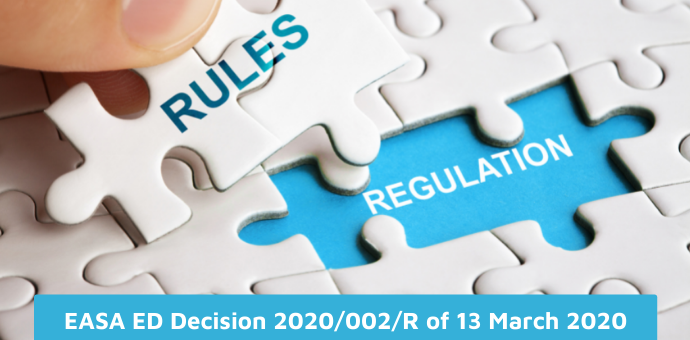Review by Sofema Aviation Services (SAS) www.sassofia.com regarding EASA ED Decision 2020/002/R of 13 March 2020
Introduction
In accordance with Basic Regulation (EU) 2018/1139, EASA issues:
- Certification specifications (CS)
- Acceptable means of compliance (AMC)
- Guidance material (GM)
For the application of Regulation (EU), 2018/1139 related to implementing & delegated acts
Note 1 – AMC are non-binding standards issued by EASA which may be used by persons and organisations to demonstrate compliance with Regulation (EU) 2018/1139 and the delegated and implementing acts adopted.
Note 2 – GM is non-binding material issued by EASA which helps to illustrate the meaning of a requirement or specification and is used to support the interpretation of Regulation (EU) 2018/1139, the delegated and implementing acts adopted on the basis thereof, certification specifications, and acceptable means of compliance.
Brief Summary of Changes
- Issued the AMC and GM to Annex I (Part-M), Annex II (Part-145), Annex III (Part-66), and Annex IV (Part-147) to Commission Regulation (EU) No 1321/2014 (Issue 2). With Decision 2016/011/R of 11 July 20165
- Issued AMC and GM to Annex Va (Part-T) to Commission Regulation (EU) No 1321/2014. With Decision 2019/009/R6
- Commission Regulation (EU) 2019/13837 amending Commission Regulation (EU) No 1321/2014:
o Introduces Part-ML (Annex Vb), which contains requirements more proportional to the General Aviation (GA) community (Opinion No 05/2016);
o Replaces the existing Part-M, Subpart G with the new Part-CAMO (Annex Vc) with safety management system (SMS) requirements applicable to continuing airworthiness management organisations (CAMOs) (Opinion No 06/2016); and
o Introduces a new simplified organisation approval Part-CAO (Annex Vd) with alleviated requirements and with combined privileges for maintenance, continuing-airworthiness management, airworthiness reviews, and permits to fly (Opinion No 05/2016).
- Commission Regulation (EU) 2019/1383 amends also the existing requirements on technical records for assessing the airworthiness status of an aircraft through:
o A reorganisation of the related requirements in Regulation (EU) No 1321/2014;
o The provision of clearer requirements on components with the establishment of a consistent record-keeping period and the introduction of various forms of record-keeping (Opinion No 13/2016).
- Commission Regulation (EU) 2019/13848 amending Regulations (EU) No 965/20129 and (EU) No 1321/2014, establishes that where an aircraft included in an air operator certificate is used for non-commercial operations or specialised operations under point ORO.GEN.310 of Annex III or point NCO.GEN.104 of Annex VII to Regulation (EU) No 965/2012, the operator shall ensure that the tasks associated with continuing airworthiness are performed by the CAMO approved in accordance with Annex Vc (Part-CAMO) or the combined airworthiness organisation (CAO) approved in accordance with Annex Vd (Part-CAO) to Regulation (EU) No 1321/214, whichever applicable, of the air operator certificate holder.
- In addition to the above, Commission Regulation (EU) 2019/1384, based on Opinion No 01/2017:
o Introduces coordination requirements between the operation, the CAMO, and the maintenance organisation involved in the execution of maintenance check flights.
- Commission Implementing Regulation (EU) 2020/27010 has amended Regulation (EU) No 1321/2014 as regards transitional measures for organisations involved in the continuing airworthiness for general aviation and continuing airworthiness management and has corrected that Regulation.
Next Steps
Sofema Aviation Services www.sassofia.com and Sofema Online www.sofemaonline.com provide classroom, Webinar, and online EASA regulatory complaint and vocational training. For comments & questions please email team@sassofia.com
Tags:
Acceptable means of compliance (AMC), aviation, Basic Regulation (EU) 2018/1139, Certification specifications (CS), EASA ED Decision 2020/002/R, EASA regulations, Guidance material (GM), Regulatory Compliance, SAS blogs




